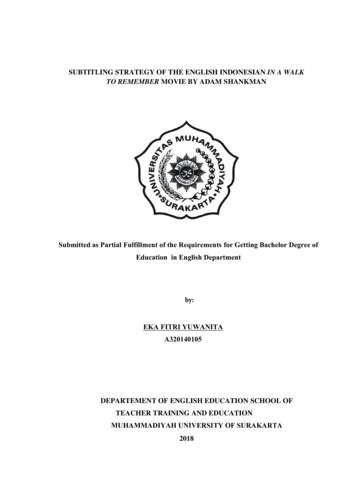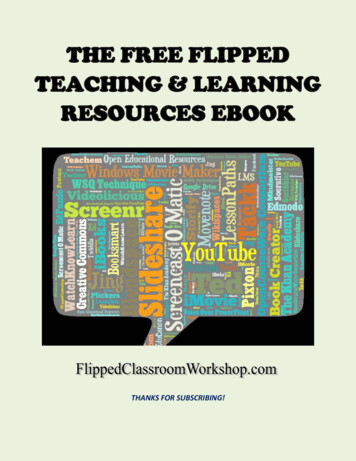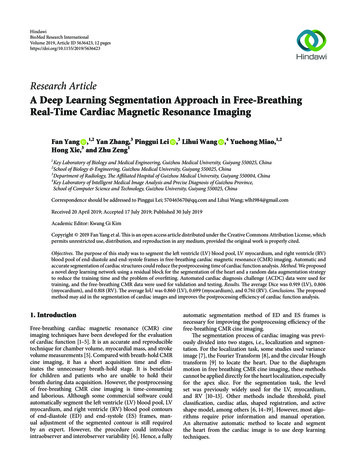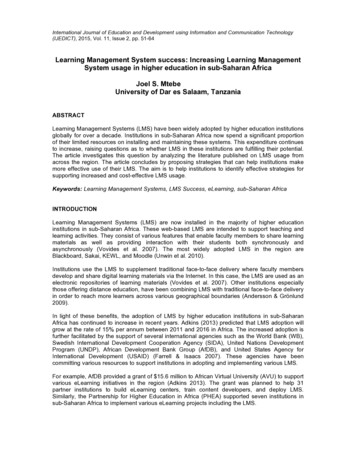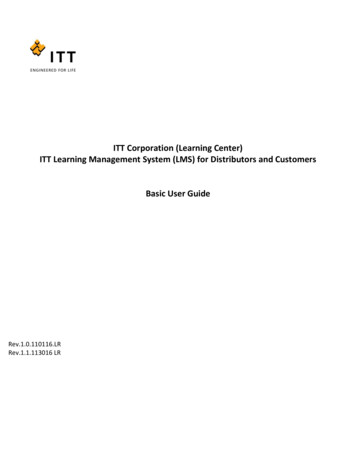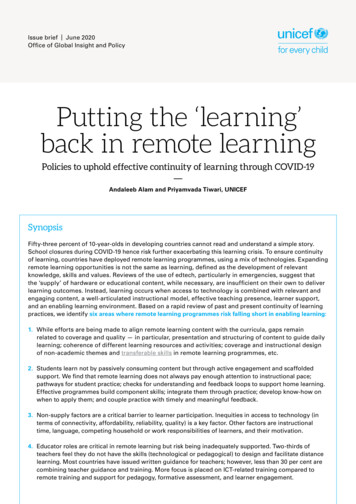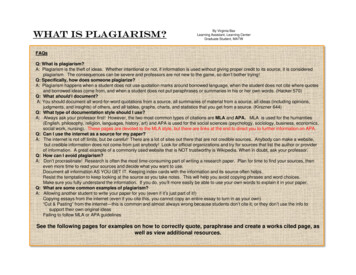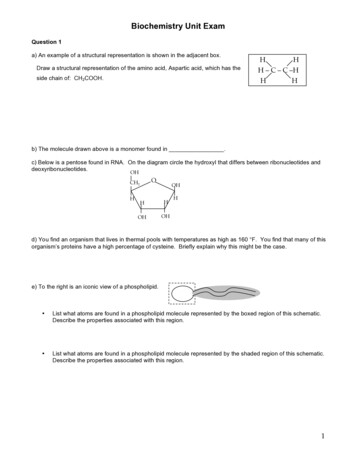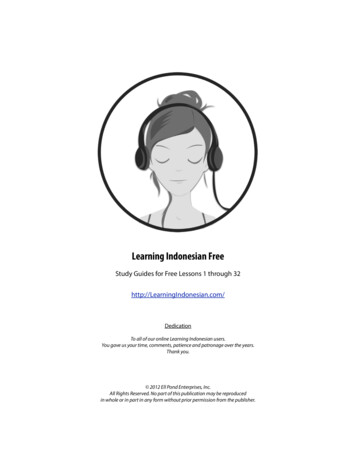
Transcription
Learning Indonesian FreeStudy Guides for Free Lessons 1 through 32http://LearningIndonesian.com/DedicationTo all of our online Learning Indonesian users.You gave us your time, comments, patience and patronage over the years.Thank you. 2012 Ell Pond Enterprises, Inc.All Rights Reserved. No part of this publication may be reproducedin whole or in part in any form without prior permission from the publisher.
ContentsIntroduction3How to Use This Guide .4Conversational Fluency: Start Right.4Indonesian Pronunciation6Pronunciation Table .6More Notes .7Lesson Study Guides9Greetings in Indonesian .9Expressing Yourself and Asking for Things.10Talking About Language and Nationality.12Introduction to Food and Drink .13Direction and Location .14Addressing People by Titles and Pronouns.15Introducing Yourself and Others .17Small Numbers .19Time and Dates .20Expressing Love and Affection.21Ordering Food and Drinks .22Days of the Week .25Big Numbers .26Emergency Expressions.27Shopping .29Past, Present and Future .30Store Hours .30Getting Lost and Directions .31Describing People.32Thoughts and Opinions .33
IntroductionThank you for trying out Learning Indonesian Free!There is no question that it takes a good amount of focus and practice on your part becomeproficient in a completely new language, both with the vocabulary and with the technicalaspects of grammar. Our promise to you is that we will do our absolute best to make it simplefor you. Your experience with Learning Indonesian is 100% about learning to speak andunderstand the Indonesian language in everyday scenarios.In short, we make sure to put communication first. We will always focus on communicationahead of grammar. Our approach works to teach you good grammar behind the scenes inpractice as you learn.If you follow a these simple suggestions, you will find the experience more enjoyable and a biteasier than you might think.It’s not an exam and you are not being graded. Just say it!You will not be graded on your mistakes. There are no marks, exams, report cards orpermanent transcripts when you are learning Indonesian with us. In a conversation, youcannot be wrong if you get your point across. You will find Indonesians do not care at allabout grammar and correctness when meeting you. Just relax and give it a go.Everyday Indonesian is not the academic form of the language.Perhaps you have taken a formal course in Indonesian or another language where grammarwas a highly-emphasized component. You may have come across tutors and other programsthat emphasize textbook-correct official Indonesian. Unfortunately, if you spoke like this inIndonesia, you’ll get some very strange looks! There is a significant divergence from what isofficially correct and what is commonly used. Indonesian is an everyday language foreveryday people and situations.We will be teaching you a good and correct form of everyday Indonesian. You can speak likethis in everyday situations across in everyday travel, family and business settings. It will, ofcourse, give you the appropriate base if you do choose to go on to study more academicforms.Practice all the time.Practicing all the time doesn’t mean studying all the time. As your are walking around in yourdaily life, think of the words for things around you. Try to give yourself a running commentaryin Indonesian (as best you can) for what your doing. You do not have to be studying topractice your Indonesian!Be yourself while speaking Indonesian.
As you learn more and more vocabulary and useful phrases, you will move from just beingunderstood to expressing what you really want to say. This is a process that happens overtime. At first, you might strain to get your point across, but soon you will be able to just beyourself. It happens without effort as a consequence of learning and practicing over time.Retake lessons.Learning Indonesian lessons are not meant to be used once and discarded. Each time youretake a lesson, you can practice specific areas such as pronunciation, speed and recall.How to Use This GuideLearning to speak and understand a language requires that you challenge yourself to listenand repeat what you hear. You might be tempted to print out this guide and read along withthe audio. Unfortunately, this will effectively short-circuit the learning process and put you ina passive learning mode.Learning Indonesian is designed to force your brain to recall the terms you have learnedentirely from your own memory. To make this as effective as possible, you should avoid usingthis guide while listening to the program or testing yourself with the audio. You can andshould review this written guide after you use the audio lessons or in between lessons in yourspare time.Conversational Fluency: Start RightThe free program that you are using now is a trimmed version of Learning IndonesianPremium. By beginning with the free program, you are skimming over the depth necessary todevelop conversational fluency and the depth of understanding that will make you aneffective Indonesian speaker. This is not a bad thing! By working with this free program, youare committing to learning some of the basics using the Learning Indonesian method.
A small request from Shaun and CiciIf you find that the approach of this free program is effective for you, please considerpurchasing Learning Indonesian Premium now.We want you to be sure you’re on the right path before you invest your precious hoursin either program.But why do we suggest purchasing the full Premium program now before finishing thefree lessons?There’s no turning back, as they say. Let us explain.Learning Indonesian Premium begins at the same point, Lesson 1, but goes intomore depth as you progress through each lesson. It is a more effective learningexperience for an equal amount of time invested, especially if you are interested indeveloping conversational fluency in Indonesian.By starting as early as possible on the Premium path, you will begin on the mosteffective and easiest learning path we developed. If you choose to finish the freelessons first, it will cost you some very significant amount of time in redundant review. Ifyour true goal is to be able to speak and understand daily Indonesian without wastingtime in the process, it is faster and more effective to choose a path now and follow itexclusively.If you are interested in developing a comfortable level of conversational fluency, visithttp://LearningIndonesian.com/ and check out Learning Indonesian Premium. It is ourbest work and you will learn so much more for your time and effort.Now, on to the study guides!Terima kasih banyak,-Cici and Shaun
Indonesian PronunciationIndonesian pronunciation is typically considered to be easy to moderate for native Englishspeakers. Contrary to what one may expect, Indonesian pronunciation may feel more like thatof a European language when compared to other languages in Southeast Asia. To makethings even easier for English speakers, Indonesian is written purely with the Latin alphabetwith very normalized pronunciation.Pronunciation TableIndonesianEnglishExample / NotesAAHFatherBBBallCCHChildDDDollEEOpen or Egg 1FFFanGGGoAlways hard G, never like JHHHatNever silent, even at the end of a word 2IEEFeet, IndonesiaUsually long, can be short like in IndonesiaJJJump or FudgeKKKeyKHKey or as in LochRare, via ArabicKSXTaxiLLLampMMMapNNNotNGNGSing 3
IndonesianEnglishExample / NotesNGGNG GFingerSecond G is always pronounced 4OOHVotePPPayQKQuran, IraqRare, via ArabicRRRRolled R 5SSSunTTTopU(Old Dutch spelling: OE)OOFoodVF, VIf or VoteUsually loanwords, often pronounced like FWWWeXXTaxiRare, usually spelled KSZZ, SZebraMore Notes1. The letter E in Indonesian can be pronounced either long or short. In written Indonesian,there is no distinction between the two pronunciations. This is really the only major spellingirregularity to be concerned about. Luckily, the E is short in the vast majority of cases.2. The letter H is always pronounced, even if it is at the end of a word. The word lebih (meaningmore) may be written phonetically in English as leh-bee-h. For Native English speakers, It mayseem strange or challenging to produce the final H as if you were expelling a little too muchair. It can also be difficult to pick it up when it is spoken if you’re not attuned to hearing it. Itwill become natural with practice.3 & 4. The letters NG in the middle of a word (ex: mengerti), are always pronounced like singer,never like finger. A hard G should not be pronounced when it is simply NG.If a hard G following an NG is required, there will always be a double GG. For example: tunggal(TUNG-gal). Because it contains the second G, the NGG should be pronounced like in finger.
Rolling your R’s!5. In Indonesian, the R is rolled. “RRRrrrrolling your RRRrrrr’s” can be difficult for most Englishspeakers. If you have trouble making this sound, try saying the word “practice”, but “flapping”the R, effectively saying “pdactice”. This flapped R can be relaxed and extended into a rolled Rwith a bit of practice.Double Vowels and the Glottal StopIf a vowel is doubled in Indonesian, (example: aa as in maaf), there should be what is referredto as a glottal stop between the two vowels. Maaf is pronounced ma’af — the ah sound isstopped quickly at the back of the throat.While not often used in American English, Some British speakers perform this glottal stop inwords like city or butter (becomes ci’y and bu’er) with a pronounced STOP at the T’s. The commonexpression Uh-Oh! or Oh-Oh!, said when something goes wrong, contains this stop. It is alsofound in the proper native pronunciation of Hawai’i.Words ending in K are often pronounced with a glottal stop. Effectively, the K at the end of aword becomes a hard stop at the back of the throat. Again, depending on where you are from,this can be difficult. Common in some British pronunciation, words ending in T may exhibitthe same stop (ex: cat, bit and bought become ca’, bi’, and bough’). This is a very similar finalglottal as in Indonesian.The final K glottal stop is quite common in Indonesian, but not necessarily universal. It mayvary between speakers from different parts of the country. Just listen to hear the stop at theend of words like tidak.This particular refinement tends to develop when you hear more native speakers andrecognize them using it.
Lesson Study GuidesGreetings in IndonesianUse with Learning Indonesian Free Lessons:1&2IndonesianEnglishSelamatSafeUsed in combination with other words to form many greetingsPagiMorningFrom very early to about 10:00-11:00 AMSiangDaytime / MiddayFrom about 10:00-11:00 AM to 3:00 PMSoreAfternoonFrom about 3:00 PM to SunsetMalamEvening / NightFrom sunset to sunriseSelamat pagi!Good morning!Selamat siang!Good day!Selamat sore!Good afternoon!Selamat malam!Good evening / night!Tip: SelamatSelamat is an extremely useful word in Indonesian. You can use it in association with manywor
Learning to speak and understand a language requires that you challenge yourself to listen and repeat what you hear. You might be tempted to print out this guide and read along with the audio. Unfortunately, this will effectively short-circuit the learning process and put you in a passive learning
